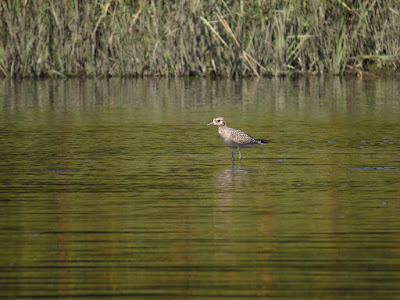It has been rainy and windy for several days as a hurricane mosies about somewhere south and east of here. Today comes sunny but with the wind down into a canoeable range somewhat shy of 15 mph. The temperature will go into the 60's as well. I set out just 10 minutes before a high high-tide.
I put in from the wildlife refuge launch It eliminates an against the tide against the wind return that I would have to deal with if I came down the river. There is one other car, with a boat rack, in the lot. I hear some bad Goose calls from about 200 yards upriver. So, it must be Goose hunting season. My Goose call translator tells me that the hunter is saying, "Stop Goose! I have a gun and I will shoot if you come closer." And, of all the birds that might be in this marsh, there is not Goose to be seen.
The hunter is near one of my usual routes, but with this tide level I can go wherever I want and even play connect the dots by plowing through the spartina from dead-end channel to dead-end channel. Even well out in the middle of the spartina, the water will be at least 2 feet deep, for a couple hours.
I head out into the center of the marsh. The only bird sightings are those that happen to be overflying the marsh as the water is too deep for the waders. As I work my way upriver, I spot a pair of Harriers hunting near the top of Nell's Island. I'm glad that I brought my binoculars - it is a handsome Hawk.
I stop at one of the marsh's catch basins and collect a bow-full of plastic trash. By number, the stupid little liquor taster bottles win out. They should be illegal as the only reason they exist is so that people can buy a handful and slam them down as they drive. Then, bottles get tossed out of the car window, which is why they are so numerous in rivers and on roadsides.
Most litter where I have paddle is "lost" items that have blown out of a garbage can or misplaced, and often shows signs of being run over or being out for a lengthy time. The tasters often look new.
 |
The dumbest piece of trash ever invented
|
At the top of the marsh, I head up into Beaver Creek. It doesn't take long to find about 15 Night Herons. They are perched in the trees, as I would expect during high tide. After a hundred yards, there are no Night Herons. Then, a Red Tail Hawk flushes from the trees. The area around that Hawk is quiet except for eight Mallards in the water below. I do not know if a Red Tail will go after a Night Heron, but I know that they do not go after Ducks except as a learned behavior. In Seattle, there was a Red Tail that learned to hunt Ducks after watching Eagles take Coots from the water. The local bird experts told me that this was one-off for them.
I flush Red Tail 3 more times, until it circles aroud and back out near the main marsh. I find a few more Night Herons and a small flock of Mallards farther up the creek. Then, I turn back, taking the shortcut over to Cat Island, where I lose the channel and have to plow through the spartina for the last 75 yards.
Heading back to my take out, I spot the Goose hunter. He is waving something that looks like a bad imitation of a bird over his head. He is either the worst Goose hunter in the world, or a Wu-Li master of hunting with telepathic techniques that no one else know. But, I have seen no Geese, and I have heard no Geese, so I think it is the former. Perhaps he is the Super Hero Goose Protector.


























